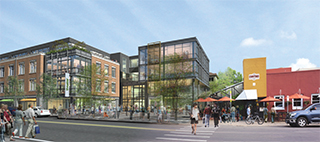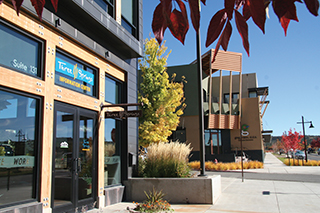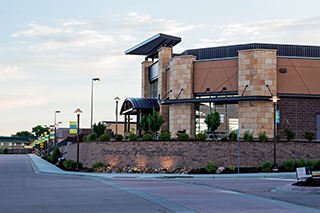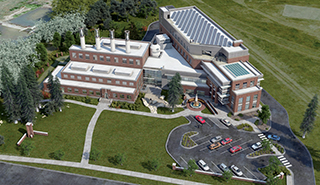

Real estate: A tale of five cities
Mike Taylor //November 1, 2013//
Following the collapse that began in 2007, Colorado’s residential real estate market has come roaring back, fueled by low interest rates, limited inventory coupled with buyer demand, and a gradually improving economy. Meanwhile, the commercial sector is at least on the mend, as evidenced by the redevelopment of Union Station in Lower Downtown Denver and other large-scale, transit-oriented developments spurred by light rail connections.
According to the Colorado Association of Realtors, the median sales price for a single-family home across the state was up 8.8 percent – to $260,000 – in the second quarter of 2013 compared to the same period a year earlier. Similarly, the price for townhouse-condo properties statewide was up 9.7 percent, to $170,000, in the second quarter.
But real estate is fundamentally local; what holds true for Denver might not apply to Durango. With that in mind, we went local with this issue’s Quarterly Real Estate Report, highlighting key developments along with overviews of five areas: Denver, Boulder, Colorado Springs and Fort Collins along the Front Range; and Durango in the Southwest.
These five snapshots provide a glimpse of what’s taking shape across the state as developers respond to pent-up demand and apply their vision to the Colorado landscape.
— Mike Taylor
 DENVER
DENVER
Denver development extends from future transit stations
Transit-oriented development is the big news on Denver’s real estate scene, with the redevelopment of historic Union Station considered the mother of all TODs.
When completed, Union Station and the 19.5 surrounding acres will be transformed into a transportation hub that includes commuter rail to north Denver metropolitan communities and Denver International Airport, Amtrak, bus service, and taxi and limousine services.
“Transportation alternatives are enormously important for the futures of our cities, and historic preservation is very important for the future of our cities,” said Dana Crawford, a longtime developer who is on the team redeveloping the old train station. “This is a coming-together of two very important urban assets.”
The historic building itself will include more than 22,000 square feet of retail space and a 112-room hotel; while the new Union Station neighborhood will include commercial, retail and residential add-ons to boot, thanks to a public-private partnership between the City of Denver, Regional Transportation District and master developers Continuum Partners and East West Partners.
“We’re coming in on time and on budget,” managing partner at East West Partners, Chris Frampton, said of the $480 million project. “We’re looking at about 700,000 square feet of new office space and 2,000 new apartment homes. Good things happen in good markets.”
Frampton called the 16th Street Mall the “spine of downtown Denver,” and added his assertion it is “the best public space in the country,” listing off competitors such as Rodeo Drive and Madison Avenue. In addition, 17th Street will become a new public gathering place with “an outdoor waiting room set with gardens and cafés, bridging transit, retail, offices, hospitality and residential users all together in one place,” Frampton said.
The build-out projects and RTD additions are scheduled for completion in 2016.
Excitement surrounding the transit hub has prompted several companies to stake claims and prime office space in the surrounding area. IMA Financial Group and Antero Resources are building new headquarters just blocks from their existing locations in Lower Downtown, and DaVita Inc. opened its new headquarters near Union Station last year after relocating from Los Angeles.
Denver Union Station may be the centerpiece of RTD’s FasTracks expansion program, but other stops along the line also are seeing a flurry of activity.
Front Range Land and Development Co. has plans for 2.2 million square feet of office space, 1,800 residential units, two hotels and 300,000 square feet of walkable retail space at its 42-acre site at Belleview Station.
The first 653-unit apartment complex is already underway, and Denver developer Prime West earlier this year announced plans to complete the first 340,000-square-foot office building at the Belleview station site.
“It’s clearly the best location in southeast Denver for a corporate relocation or expansion,” said Stephen Clarke, president and CEO of Prime West. “We’re still seeking an anchor tenant. We have several interested parties.”
With the frenzy of activity surrounding FasTracks, one Denver-based nonprofit wants to ensure there is ample work-force housing near stations. Since 2007, the Urban Land Conservancy (ULC) has completed 19 transactions, eight of which are using Denver’s $15 million Transit-Oriented Development Fund. The fund was created to preserve and develop affordable housing around bus and train depots.
ULC and Medici Communities LLC recently opened the $12.3 million Evans Station Lofts, bringing 50 affordable housing units to the Evans Light Rail Station TOD.
Denver’s residential market is also vibrant, with the number of homes sold in August up 20.3 percent compared to the same month a year ago, according to an analysis of Metrolist data by independent real estate consultant Gary Bauer. The $287,000 median price for a home in Denver is up 9.5 percent compared to last year. The number of homes on the market also is beginning to stabilize at around 10,500 units.
“At our low we were at 6,600 units,” Bauer said. “Now we’re able to meet buyer demand, which is still strong. Do homes come on the market and go under contract within a day? Yes, but before it was within hours.”
— Margaret Jackson
 BOULDER
BOULDER
With growth management restrictions, Boulder bets on
infill projects
With Boulder’s economy pumped up by high-tech companies and startups coming out of the University of Colorado, developers are snatching up infill property in an effort to capitalize on the flurry of activity.
A low vacancy rate and Boulder’s stringent growth-management policies make it difficult for companies to find office space within city limits, so they often look to other areas within the county. While Rally Software recently announced plans to add 89,000 square feet to its headquarters, Ball Aerospace is leasing 48,000 square feet at Lafayette Corporate Campus and Medtronic surgical navigation systems is leasing 41,000 square feet at Colorado Technology Center in Louisville.
“There’s a lot of publicly owned land on the outskirts of Boulder, so there’s no way to go outward,” said Steve Kawulok, managing director of Sperry Van Ness/The Commercial Group. “The activity in Boulder is mostly around redevelopment.”
One of the most high-profile projects is the redevelopment of the old Boulder Daily Camera building at 11th and Pearl streets. Denver-based Nichols Partnership paid $13.5 million for the site, to be called West Pearl, in November that will add 46,000 square feet of offices, 15,000 square feet of public landscaped rooftop, three levels of structured parking and a movie theater below grade. Retail and restaurant space will be added at street level and offices will occupy the top three floors.
“Office space will appeal to creative, tech-based companies including startups,” said Dan Schuetz, project manager.
Among the biggest projects proposed in Boulder is a 400-seat amphitheater and a pair of four-story office buildings totaling 202,500 square feet, and 6,000 square feet of retail space in addition to the offices at 30th and Pearl streets. The project also includes a 120-room hotel. Pearl Place Associates LLC, formed by principals of Denver-based Brickstone Partners and Forum Real Estate Group, paid $11.2 million for three parcels in July and has a fourth under contract.
Nearby, another major project is taking shape. Depot Square, in the heart of Boulder Junction, includes an underground Regional Transportation District bus station and a 400-vehicle parking structure wrapped by 71 affordable housing units slated for delivery by the first quarter of 2015. Pedersen Development Co. is also working on a 150-room Hyatt Place Hotel on the site and renovating the historic train depot the city relocated to the property several years ago.
{pagebreak}
Boulder’s residential market has rebounded as well, with the number of homes sold up 7.3 percent for the first half of the year. The median sales price is up 9.2 percent to $415,000 compared to 2012.
“The hottest part of the Boulder market is anything in town that’s beneath $600,000 or $700,000,” said Duane Duggan, a broker with RE/MAX of Boulder. “If you back up to open space, it’s extremely hot.”
Duggan doesn’t expect the market will be significantly harmed by the devastating flooding in September.
“People still want to live in Boulder and there are still jobs in Boulder,” he said. “It [puts] a damper on business, but there will be a lot of jobs created to clean this mess up and rebuild.”
— Margaret Jackson
 DURANGO
DURANGO
Southwest Colorado: Durango’s Sustainable Three Springs Community
The Southern Ute Tribe is moving ahead as master developer of the 680-acre Three Springs master-planned community. Just seven miles from Durango’s city center, the development debuted in 2006 with the opening of the new $76 million Mercy Regional Medical Center. A year later, new homes were already occupied by dozens of the hospital’s 1,000 employees, as well as by La Plata County young families, empty nesters, rural residents and out-of-staters.
“Our goal was to first deliver the infrastructure to the hospital, and then follow that up with homes for hospital employees and other customers of the Durango housing market,” said Three Springs Real Estate Portfolio Manager Tim Zink.
Three Springs has approval for more than 2,200 residential units, including single-family homes (current market “sweet spot” is about $300,000), and multifamily dwellings. Commercial development is underway with 362,000 square feet of hospital and medical offices. There’s an additional 82,000 square feet of retail and office space in the Mercado District. Tenants include State Farm, Progressive Insurance, American Home Patient, Anytime Fitness, Alpine Bank, Digs Restaurant and Bar and others interested in leveraging hospital-related business.
The community’s traditional neighborhood development with alley-accessed garages, pedestrian-friendly walkways, pocket parks and trails, has proven popular. Dozens of residents walk to work at the hospital and nearby services.
“Part of the TND (Traditional Neighborhood Development) design is to live, work and recreate in the same general area so you don’t have to drive,” Zink explained, adding that a unique aspect of the Southern Ute Indian Tribe’s operating philosophy is to support smart development. That includes green building standards, recyclable materials, an on-site construction recycling center, and storm water redirected from the roof to planters rather than dumped in the streets.
“We put a lot of thought
into how we impact the land,” Zink said.
— Becky Hurley
 COLORADO SPRINGS
COLORADO SPRINGS
Despite natural disasters and economic struggles, Colorado Springs region rebounds
Colorado Springs’ commercial and residential real estate markets have seen significant improvement this year, due primarily to an infusion of resources by local rather than national or regional investors.
As a result Turner Commercial Research reported that through the second quarter, commercial property sales rose 44 percent compared to the same period in 2012.
Residential sales also benefited from a double-digit decrease in reported foreclosures and a solid rise in new home sales. Single-family permits in August rose, year-over-year, by 36 percent.
Property owners and brokers leaned in, facing shifting national economic headwinds and challenges from Mother Nature. Losses sustained during the Black Forest fire and subsequent flooding as well as federal budget cutbacks to the military and civilian defense sectors contributed to a less-than-full economic recovery. By fourth quarter, Colorado Springs’ unemployment hovered near 8 percent.
Still, bright spots outnumbered clouds on the economic horizon, both in the commercial and residential sectors.
T5@Colorado “Vineyard” Data Center
One of the western United States’ greenest data center campuses has broken ground in south Colorado Springs. The 64-acre T5@Colorado “Vineyard” project was annexed by the city council in 2010 and approved as a special taxing district with public improvement fee funding. At build-out, the complex will represent about $1 billion in investment according to managing partner Vince Colarelli.
So far at least three letters of intent have been submitted for the first building. Colarelli is in active negotiations with several more prospective clients for additional buildings. Moreover, the project has received funding through a capital partnership with Iron Point Partners in Washington, D.C. Developed in conjunction with other data center campuses, T5@Colorado will become part of a national portfolio.
Leasing candidates for similar data centers are typically Fortune 100 companies.
“The Vineyard data center park will take advantage of free cooling and gray water to be one of the region’s greenest data center projects,” Colarelli said, noting that leasing activity has been even stronger than anticipated.
“Demand in our market for this use outpaces supply by 17 percent,” he said. “Colorado Springs is very underserved.”
University Village Colorado Shopping Center
University Village Colorado Shopping Center, the $100 million retail centerpiece of a revitalized North Nevada Avenue corridor near the University of Colorado Colorado Springs campus, headlined commercial development this year. Launched in 2009, the project is the product of a partnership between city leaders, developers and the university. The shopping center also benefited from Colorado Springs Urban Renewal
{pagebreak}
Authority-approved special taxing district eligibility. A once-blighted 80-acre parcel, the retail property now generates millions of dollars in sales-tax-revenue and serves as a key UCCS student employment center.
More than 30 tenants have already leased space in the 80-acre retail hub, according to private developers Kevin Kratt and Tom Cone.
Kratt credits early decisions by anchors Costco, Kohl’s and Lowe’s as well as the center’s proximity to the campus for its thriving occupancy.
“We opened just as the recession hit bottom – most new retail centers wouldn’t have made it. So far, though, we haven’t lost a single tenant,” he said, adding that University Village has become “a true community center.”
UCCS Executive Vice Chancellor Brian Burnett said the project became a priority when deteriorating conditions along the North Nevada corridor began to affect the university’s ability to attract new students and capital investment. The university lobbied city council as early as 2003 to get Urban Renewal Authority approval for special taxing incentives and to create the partnership.
“The university has become a powerful local economic engine. This development was vital to our future,” Burnett said.
Today the project’s bonds are being repaid, and momentum along the corridor continues with two new projects: the $17.6 million Lane Center for Academic Health Sciences and a $20 million Capstone Collegiate Communities’ 600-bed-student housing complex.
Banning Lewis Ranch
Last year Oakwood Homes purchased almost 3,000 acres of bank-owned land for $16 million. The property was part of the original 22,000-acre Banning Lewis Ranch on the city’s east side. The new master-planned community will eventually include 9,500 residents, shopping districts, schools and parks, says Oakwood Homes CEO and Chairman Pat Hamill.
Home sales have been brisk. The company’s six new neighborhoods led the city in new home sales for the second quarter and earned nine 2013 Parade of Homes awards. As of Oct. 1, more than 200 homes had sold.
Hamill said Oakwood will partner with other developers on future commercial, recreational and active adult living opportunities.
Further south the remaining 18,000 acres at Banning Lewis Ranch was put back on the market by the owner, Houston-based Ultra Petroleum. The company announced this summer that it was abandoning plans to drill on the property when initial tests showed existing oil was “too immature.”
— Becky Hurley
 FORT COLLINS
FORT COLLINS
Commercial and residential make comebacks in Fort Collins
While expansions of craft breweries regularly make the news in Fort Collins, the recovery of the city’s commercial and residential real estate markets is largely the result of an improving economy that’s enabled alternative energy and high-tech businesses to expand and build new campuses.
“It’s been pretty active compared to a few years ago,” said Peter Kast, broker/partner with Realtec. “Commercial lending is just starting to come unglued. Banks are back in the market.”
The biggest project in the works is the $200 million corporate campus Woodward Inc. is building for its global headquarters. With the new campus, the company, which designs and manufactures control systems for the aerospace and energy markets, expects to add 700 jobs over the next 10 years.
Woodward’s expansion comes at the same time Colorado State University’s Engines & Energy Conversion Laboratory is growing. Long a supporter of the lab, Woodward is helping fund its $18.5 million expansion, where the company intends to collaborate and research with CSU faculty and students.
In addition to Woodward, Cummings and Caterpillar also will have a presence in the LEED Platinum facility.
“This is creating a lot of interest in Fort Collins,” said Bob Hosanna, senior design manager at The Neenan Co., which designed and is building the project. “Cummings and Caterpillar would not even look at Fort Collins, but now they have a presence, which adds to the vitality of downtown.”
Woodward isn’t the only entity expanding in Fort Collins. Others include:
• Avago Technologies Wireless Manufacturing, which is planning a $20 million addition to its 70-acre campus.
• Fort Collins Museum of Discovery, which will start a 47,000-square-foot expansion early next year.
• Banner Health’s new 145,000-square-foot hospital, expected to open in 2015.
• Alberta Development’s proposed $250 million redevelopment of Foothills Mall.
“The total potential project cost is $1.2 to $1.5 billion over the next few years,” said Walt Elish, president and CEO of the Northern Colorado Economic Development Corp.
The residential market is also booming, with a year-to-date increase in sales of 17.5 percent. With just a two-month supply of inventory – normal is about six months – the average sales price of a home in Fort Collins is up 7.3 percent.
“It’s a scramble because there are more buyers than sellers,” said Dave Pettigrew, broker/owner of Fort Collins Relocation.
The thriving market also is seeing the large home builders that left during the recession return. So far this year, 130 permits for new homes have been issued in Fort Collins, compared with 131 for all of 2012.
Multi-family development also is taking off. McWhinney is near completion of The Trails at Timberline, a 314-unit pet-friendly community at 2451 S. Timberline Road that includes community garden plots, a golf simulator and a two-lane bowling alley.
“The Fort Collins market, unlike parts of metro Denver, has not had the influx of new apartment buildings, so we believe there’s significant unmet demand,” said John Shaw, president of Loveland-based McWhinney.
— Margaret Jackson
























